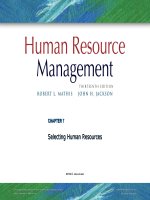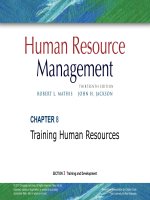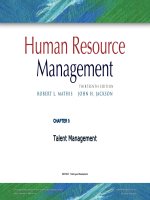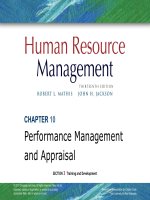Human resrouce management 13th mathis jacson chapter 01
Bạn đang xem bản rút gọn của tài liệu. Xem và tải ngay bản đầy đủ của tài liệu tại đây (1.51 MB, 34 trang )
CHAPTER 1
Human Resource Management in Organizations
SECTION 1 Environment for Human Resource Management
©
© 2011
2011 Cengage
Cengage Learning.
Learning. All
All rights
rights reserved.
reserved. May
May not
not be
be scanned,
scanned, copied
copied or
or duplicated,
duplicated, or
or posted
posted to
to aa
publicly
publicly accessible
accessible Web
Web site,
site, in
in whole
whole or
or in
in part.
part.
PowerPoint
PowerPoint Presentation
Presentation by
by Charlie
Charlie Cook
Cook
The
The University
University of
of West
West Alabama
Alabama
Chapter Objectives
After you have read this chapter, you should be able to:
•
Define human capital and identify the seven categories
of HR activities.
•
Discuss how organizational culture and HR are related and identify four areas that are part of these
relationships.
•
•
•
Explain how organizational ethical issues affect HR management.
Provide an overview of six challenges facing HR today.
Describe how the major roles of HR management
are being transformed.
•
Explain the key competencies needed by HR professionals and why certification is important.
© 2011 Cengage Learning. All rights reserved. May not be scanned, copied or duplicated, or posted to a publicly accessible Web
site, in whole or in part.
1–2
Nature of Human Resource Management
• Human Resource (HR) Management
Designing management systems to ensure that human talent is used effectively and
efficiently to accomplish organizational goals.
• Who Is an HR Manager?
In the course carrying out their duties, every operating manager is, in essence, an HR
manager.
HR specialists design processes and systems that operating managers help implement.
© 2011 Cengage Learning. All rights reserved. May not be scanned, copied or duplicated, or posted to a publicly accessible Web
site, in whole or in part.
1–3
Types of Organizational Assets
Assets
Physical
Financial
Intangible
Human
© 2011 Cengage Learning. All rights reserved. May not be scanned, copied or duplicated, or posted to a publicly accessible Web
site, in whole or in part.
1–4
FIGURE 1–1
Core Competencies in Possible HR Areas
© 2011 Cengage Learning. All rights reserved. May not be scanned, copied or duplicated, or posted to a publicly accessible Web
site, in whole or in part.
1–5
Human Capital in Organizations
Human Capital
Core Competency
The collective value of the capabilities, knowledge,
A unique capability that creates high value and
skills, life experiences, and motivation of an
differentiates an organization from its competition.
organizational workforce.
© 2011 Cengage Learning. All rights reserved. May not be scanned, copied or duplicated, or posted to a publicly accessible Web
site, in whole or in part.
1–6
FIGURE 1–2
HR Management Functions
© 2011 Cengage Learning. All rights reserved. May not be scanned, copied or duplicated, or posted to a publicly accessible Web
site, in whole or in part.
1–7
HR Management: Interlinked Functions
1.
2.
3.
4.
5.
6.
7.
Strategic HR Management
Equal Employment Opportunity
Staffing
Talent Management and Development
Total Rewards: Compensation and Benefits
Risk Management and Worker Protection
Employee and Labor Relations
© 2011 Cengage Learning. All rights reserved. May not be scanned, copied or duplicated, or posted to a publicly accessible Web
site, in whole or in part.
1–8
Organizational Culture and HR
• Organizational Culture
Is the shared values and beliefs in an organization.
Is the internal “climate” of the organization that employees, managers, customers, and
others experience.
Positively affects service and quality, productivity, and financial results when aligned with
HR values and organizational goals.
Is affected by differences in cultural dimensions from country to country and even within
countries.
© 2011 Cengage Learning. All rights reserved. May not be scanned, copied or duplicated, or posted to a publicly accessible Web
site, in whole or in part.
1–9
Hofstede’s Dimensions of Culture
Individualism/
Inequality
Group
of Power
Orientation
Culture
Long-term/
Masculinity/
Short-term Orientation
Femininity
Uncertainty Avoidance
© 2011 Cengage Learning. All rights reserved. May not be scanned, copied or duplicated, or posted to a publicly accessible Web
site, in whole or in part.
1–10
Organizational Productivity
Productivity
Unit Labor Cost
A measure of the quantity
A measure of HR productivity computed by dividing
and quality of work done, considering the cost of
the average cost of workers by their average levels
the resources used.
of output.
© 2011 Cengage Learning. All rights reserved. May not be scanned, copied or duplicated, or posted to a publicly accessible Web
site, in whole or in part.
1–11
Approaches to Improving Organizational Productivity
FIGURE 1–3
Restructuring the Organization
•
•
•
Re-Designing Work
Revising organizational structure
•
•
Reducing staff
Changing workloads and combining jobs
Reshaping jobs due to technology changes
Aiding in mergers and acquisitions
Goals
•
Increase
organizational productivity
•
Reduce unit
labor costs
Aligning HR Activities
•
•
•
Outsourcing
Attracting and retaining employees
Training, developing, and evaluating employees
Compensating employees and other
•
•
Using domestic vendors/contractors instead of employees
Outsourcing operations internationally
HR activities
© 2011 Cengage Learning. All rights reserved. May not be scanned, copied or duplicated, or posted to a publicly accessible Web
site, in whole or in part.
1–12
Social Responsibilities and HR
• HR Advantages and Social Responsibilities
Attracting and retaining employees
Achieving sustainability in dealing
with economic challenges
Creating a “green culture”
• Global Social Responsibility and HR
Results in higher organizational images globally, better employee morale and loyalty, and
more competitive advantages with consumers
© 2011 Cengage Learning. All rights reserved. May not be scanned, copied or duplicated, or posted to a publicly accessible Web
site, in whole or in part.
1–13
Customer Service and Quality Linked to HR
• Linking HR to social responsibility, customer service, and quality significantly affects
organizational effectiveness.
Human Resource Management
Social Responsibility
Quality
Customer Service
© 2011 Cengage Learning. All rights reserved. May not be scanned, copied or duplicated, or posted to a publicly accessible Web
site, in whole or in part.
1–14
Employee Engagement and HR Culture
• Employee Engagement
Is the extent to which individuals feel linked to organizational success and how the
organization performs positively.
• Social Networking
Involves communicating to other employees, nonwork friends, community contacts, and
others.
Has evolved from personal contacts and oral communications to include:
E-mail and text messages
Twitters
Blogs
© 2011 Cengage Learning. All rights reserved. May not be scanned, copied or duplicated, or posted to a publicly accessible Web
site, in whole or in part.
1–15
FIGURE 1–4
Business Ethics and HR Management Consequences
© 2011 Cengage Learning. All rights reserved. May not be scanned, copied or duplicated, or posted to a publicly accessible Web
site, in whole or in part.
1–16
Ethical Behavior and Organizational Culture
Ethics Program Elements
Written code of ethics
Employee training on
Advice to employees
Confidential reporting
and standards of conduct
ethical behaviors
on ethical situations
of ethical problems
© 2011 Cengage Learning. All rights reserved. May not be scanned, copied or duplicated, or posted to a publicly accessible Web
site, in whole or in part.
1–17
HR’s Role in Organizational Ethics
Legal Question
•
Does the behavior or result meet all
Ethical Question
•
Does the behavior or result meet both
applicable laws, regulations, and
organizational standards and professional
government codes?
standards of ethical behavior?
© 2011 Cengage Learning. All rights reserved. May not be scanned, copied or duplicated, or posted to a publicly accessible Web
site, in whole or in part.
1–18
FIGURE 1–5
Examples of HR-Related Ethical Misconduct Activities
© 2011 Cengage Learning. All rights reserved. May not be scanned, copied or duplicated, or posted to a publicly accessible Web
site, in whole or in part.
1–19
HR Ethics and Sarbanes-Oxley (SOX)
• Reduce the likelihood of illegal and unethical behaviors by:
Having a written code of ethics and conduct standards
Providing ethical behavior training and advice
Establishing confidential reporting systems for ethical misconduct
Providing whistle-blower protection
Supporting HR’s role as “keeper and voice” of organizational ethics
© 2011 Cengage Learning. All rights reserved. May not be scanned, copied or duplicated, or posted to a publicly accessible Web
site, in whole or in part.
1–20
Current HR Management Challenges
Organizational Cost Pressures and
Economics
Restructuring
and
Job Changes
Human
Resource
Management
Globalization of Organizations
Workforce Demographics
and Diversity
and HR
© 2011 Cengage Learning. All rights reserved. May not be scanned, copied or duplicated, or posted to a publicly accessible Web
site, in whole or in part.
1–21
Economics and Job Changes
Future
Job Change Concerns
Occupational Shifts
Workforce Availability and
Quality
Growth in Contingent
Talent Management
Workforce
© 2011 Cengage Learning. All rights reserved. May not be scanned, copied or duplicated, or posted to a publicly accessible Web
site, in whole or in part.
1–22
FIGURE 1–6
Fastest Growth in Job Changes to 2016
Source: U.S. Bureau of Labor Statistics, www.bls.gov.
© 2011 Cengage Learning. All rights reserved. May not be scanned, copied or duplicated, or posted to a publicly accessible Web
site, in whole or in part.
1–23
FIGURE 1–7
Hourly Compensation Costs for Manufacturing Production Workers
Source: U.S. Bureau of Labor Statistics, www.bls.gov.
© 2011 Cengage Learning. All rights reserved. May not be scanned, copied or duplicated, or posted to a publicly accessible Web
site, in whole or in part.
1–24
HR Technology
• Human Resource Management System (HRMS)
An integrated system providing information used by HR management in decision making.
• Purposes of HRMS Data Collection
Administrative and operational efficiency in :
Automation of payroll and benefit activities
EEO/affirmative action tracking
Web-based communication with employees
Availability of data for HR strategic planning
© 2011 Cengage Learning. All rights reserved. May not be scanned, copied or duplicated, or posted to a publicly accessible Web
site, in whole or in part.
1–25









